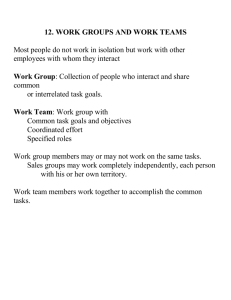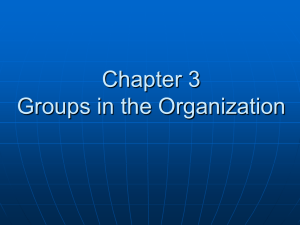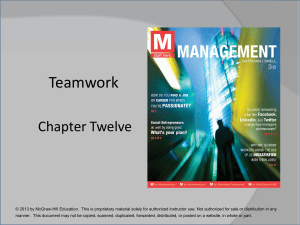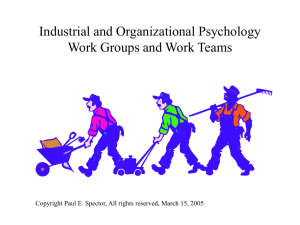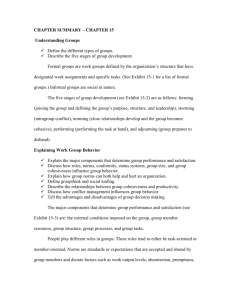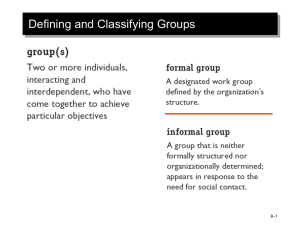PS2340 Chapter 7 - Paul Tilley's Resource Wiki
advertisement
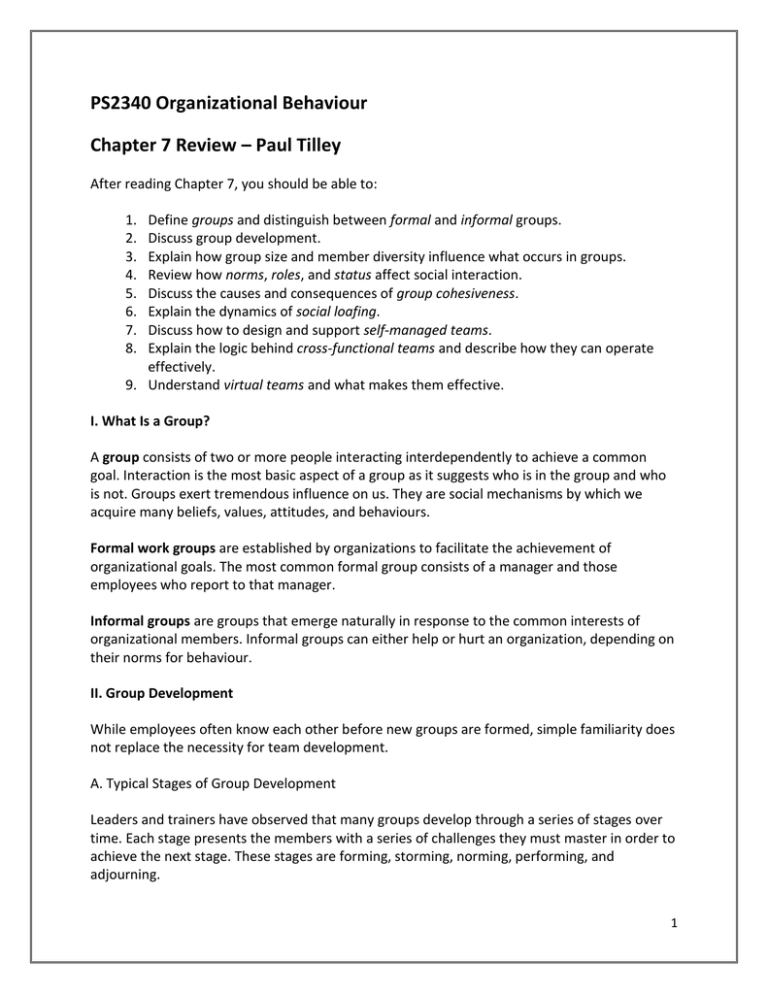
PS2340 Organizational Behaviour Chapter 7 Review – Paul Tilley After reading Chapter 7, you should be able to: 1. 2. 3. 4. 5. 6. 7. 8. Define groups and distinguish between formal and informal groups. Discuss group development. Explain how group size and member diversity influence what occurs in groups. Review how norms, roles, and status affect social interaction. Discuss the causes and consequences of group cohesiveness. Explain the dynamics of social loafing. Discuss how to design and support self-managed teams. Explain the logic behind cross-functional teams and describe how they can operate effectively. 9. Understand virtual teams and what makes them effective. I. What Is a Group? A group consists of two or more people interacting interdependently to achieve a common goal. Interaction is the most basic aspect of a group as it suggests who is in the group and who is not. Groups exert tremendous influence on us. They are social mechanisms by which we acquire many beliefs, values, attitudes, and behaviours. Formal work groups are established by organizations to facilitate the achievement of organizational goals. The most common formal group consists of a manager and those employees who report to that manager. Informal groups are groups that emerge naturally in response to the common interests of organizational members. Informal groups can either help or hurt an organization, depending on their norms for behaviour. II. Group Development While employees often know each other before new groups are formed, simple familiarity does not replace the necessity for team development. A. Typical Stages of Group Development Leaders and trainers have observed that many groups develop through a series of stages over time. Each stage presents the members with a series of challenges they must master in order to achieve the next stage. These stages are forming, storming, norming, performing, and adjourning. 1 Forming. Group members try to orient themselves by “testing the waters”. Storming. Confrontation and criticism occur as members determine whether they will go along with the way the group is developing. Norming. Members resolve the issues that provoked the storming, and they develop social consensus. Performing. The group devotes its energies toward task accomplishment. Adjourning. Rites and rituals that affirm the group’s previous successful development are common. Members often exhibit emotional support for each other. B. Punctuated Equilibrium When groups have a specific deadline by which to complete some problem-solving task, we often observe a very different development sequence from that described above. The punctuated equilibrium model is a model of group development that describes how groups with deadlines are affected by their first meetings and crucial midpoint transitions. Phase 1. Phase 1 begins with the first meeting and continues until the midpoint in the group’s existence. Although it gathers information and holds meetings, the group makes little visible progress toward the goal. Midpoint Transition. The midpoint transition occurs at almost exactly the halfway point in time toward the group’s deadline. The transition marks a change in the group’s approach, and how the group manages it is critical for the group to show progress. Phase 2. Decisions and approaches adopted at the midpoint get played out in Phase 2. It concludes with a final meeting that reveals a burst of activity and a concern for how outsiders will evaluate the product. III. Group Structure and Its Consequences Group structure refers to the characteristics of the stable social organization of a group, the way a group is “put together.” The most basic structural characteristics along which groups vary are size and member diversity. A. Group Size Although the smallest possible group would consist of two people, most work groups, including task forces and committees usually have between three and twenty members. 2 Size and Satisfaction. In general, members of larger groups report less satisfaction with group membership than those who find themselves in smaller groups. Increased potential for conflict, reduced opportunity for participation, inhibition, and inability to identify contributions to the group are among the reasons for this phenomenon. Size and Performance. Different types of tasks are performed by groups where performance could depend upon the type of task and the number of individuals involved. For some tasks, like moving a heavy rock, the potential performance of the group increases with group size. These are additive tasks in which group performance is dependent on the sum of the performance of individual group members. Other tasks, like searching for a single error in a complicated computer program, also may show performance gains as group size increases, but that is because the chance of including a crucial problem solver is greater. Disjunctive tasks are tasks in which performance is dependent on the performance of the best group member. However, as groups get larger, performance may also decrease as a function of process losses. Process losses are group performance difficulties stemming from the problems of motivating and coordinating larger groups. Thus, actual performance = potential performance – process losses. Finally, group performance on conjunctive tasks, like assembly line work, decreases as group size increases. Conjunctive tasks are tasks in which group performance is limited by the performance of the poorest group member. B. Diversity of Group Membership Research suggests that heterogeneous or diverse groups have a more difficult time communicating and becoming cohesive, so group development takes longer. Once developed, diversity has little impact on performance and sometimes performance is better on tasks that require creativity and problem solving. C. Group Norms Social norms are collective expectations that members of social units have regarding the behaviour of each other. They are codes of conduct that specify what individuals should do and not do and standards against which we evaluate the appropriateness of behaviour. All of us are influenced by norms which regulate many of our daily activities. Norm Development. Norms develop to provide regularity and predictability to behaviour. They develop to regulate behaviours that are considered at least marginally important. Individuals comply with these norms because the norms often correspond to privately held attitudes. 3 Some Typical Norms. There are different types of norms in organizations which affect the behaviour of members. Norms that seem to crop up in most organizations and affect the behaviour of members include the following: Dress norms. Social norms frequently dictate the kind of clothing people wear to work. Reward allocation norms. There are at least four norms that might dictate how rewards, such as pay, promotions, and informal favours, could be allocated in organizations: equity, equality, reciprocity, and social responsibility. Performance norms. The performance of organizational members might be as much a function of social expectations as it is of inherent ability, personal motivation, or technology. D. Roles Roles are positions in a group that have a set of expected behaviours attached to them. Roles represent “packages” of norms that apply to particular group members. In organizations, there are two basic kinds of roles. First, there are designated or assigned roles that are formally prescribed by an organization to facilitate task achievement. Assigned roles indicate "who does what." and "who can tell others what to do." In addition, there are also emergent roles which are roles that develop naturally to meet the social-emotional needs of group members or to assist in formal job accomplishment. Role Ambiguity. Role ambiguity exists when the goals of one's job or the methods of performing it are unclear. Ambiguity might be characterized by confusion about how performance is evaluated, how good performance can be achieved, or what the limits of one’s authority and responsibility are. A variety of elements can lead to ambiguity. Organizational factors. Some roles seem inherently ambiguous because of their function in the organization. The role sender. Role senders might have unclear expectations of a focal person. The focal person. Even role expectations that are clearly developed and sent might not be fully digested by the focal person. The practical consequences of role ambiguity include job stress, dissatisfaction, reduced organizational commitment, and intentions to quit. Managers can reduce role ambiguity by providing clear performance expectations and performance feedback. Role Conflict. Role conflict exists when an individual is faced with incompatible role expectations. There are several different types of role conflict. Intrasender role conflict occurs when a single role sender provides incompatible role expectations to a role occupant. Intersender role conflict occurs when two or more role senders provide a role occupant with incompatible expectations. 4 Interrole conflict occurs when several roles held by a role occupant involve incompatible expectations. Person-role conflict occurs when role demands call for behaviour that is incompatible with the personality or skills of the role occupant. The most consistent consequences of role conflict are job dissatisfaction, stress reactions, lowered organizational commitment, and turnover intentions. Managers can help prevent role conflict by avoiding self-contradictory messages, conferring with other role senders, being sensitive to multiple role demands, and fitting the right person to the right role. E. Status Status is the rank, social position, or prestige accorded to group members. It represents the group’s evaluation of a member. Organizations have both formal and informal status systems. Formal Status Systems. The formal status system represents management’s attempt to publicly identify those people who have higher status than others. This is accomplished by the application of status symbols. Status symbols are tangible indicators of status. Status symbols might include titles, particular working relationships, the pay package, the work schedule, and the physical working environment. The criteria for achieving formal organizational status includes seniority in one’s work group and one’s assigned role in the organization. Informal Status Systems. Informal status symbols also exist in organizations and can operate just as effectively. Sometimes, job performance is a basis for the acquisition of informal status. So a good hitter or a good performer will be accorded status, although status symbols might be lacking. Consequences of Status Differences. Status affects the ways in which people communicate with each other. Most people like to communicate with others at their own status or higher, rather than with people who are below them. As a result, communication is likely to move up the status hierarchy in organizations. As well, higher status people do more talking and have more influence. Reducing Status Barriers. Although status differences can be powerful motivators, status differences also tend to inhibit the free flow of communication in organizations and can make it more difficult to foster a culture of teamwork and cooperation. As a result, many organizations are doing away with status symbols such as executive dining rooms, and reserved parking in an attempt to foster a culture of teamwork and cooperation across the ranks. The use of e-mail has also been found to level status barriers, thus facilitating communication between people at all levels of the organization. 5 IV. Group Cohesiveness Group cohesiveness is a critical property of groups. Cohesive groups are those that are especially attractive to their members. Members are especially desirous of staying in the group and tend to describe the group in favourable terms. A. Factors Influencing Cohesiveness There are several important factors which might make one group more cohesive than others. Threat and Competition. External threat and competition can force members to work together when group goals are in danger. External threats to survive have often resulted in greater cohesiveness. Success. When a group accomplishes a goal, members feel pride and tend to become more cooperative with each other as the group becomes more attractive to its members. Member Diversity. Task accomplishment will be a more important factor than member similarities in determining cohesiveness. Size. Larger groups have a more difficult time in becoming and staying cohesive. Toughness of Initiation. Groups that are tough to get into are more attractive than those that are easy to join. B. Consequences of Cohesiveness There are a number of consequences of group cohesiveness. More Participation in Group Activities. Because cohesive groups are attractive to their members, they should be especially motivated to participate in group activities. More Conformity. Because they are so attractive and coordinated, cohesive groups are well equipped to supply information, rewards, and punishment to individuals. Thus, highly cohesive groups are in a superb position to induce conformity to group norms. More Success. Cohesiveness contributes to group success. In general, cohesive groups are good at achieving their goals. That is, cohesive groups tend to be successful in accomplishing what they wish to accomplish. In a good labour relations climate, group cohesiveness should foster high productivity. In a climate marked by tension and disagreement, cohesive groups might pursue goals that result in low productivity. Thus, cohesive groups tend to produce more or less than non-cohesive groups. In addition, there is less variability in the productivity of members of cohesive groups. 6 V. Social Loafing Social loafing is the tendency to withhold physical or intellectual effort when performing a group task. It is one of the reasons for process losses in large groups and takes two forms. In the free rider effect, people lower their effort to get a free ride at the expense of other group members. This is the phenomenon of others not pulling their weight on a group project. In the sucker effect, people lower their effort because of the feeling that others are free riding. That is, they are trying to restore equity in the group. There are a number of ways to counteract social loafing. Make individual performance more visible. The simplest way to do this is to keep the group small. Make sure that the work is interesting. If the work is involving, intrinsic motivation should counteract social loafing. Increase feelings of indispensability. Training and the status system can provide group members with unique inputs. Increase performance feedback. Increased feedback from the boss, peers, and customers should encourage self-correction. Reward group performance. Members are more likely to monitor and maximize their own performance when the group receives rewards for effectiveness. VI. What Is a Team? Some writers have suggested that a “team” is different from a “group” because in a team a synergy develops such that the group’s efforts are greater than the sum of its parts. However, the term “team” is more generally used to describe “groups” in organizational settings and the terms can be used interchangeably. Many organizations now use team-based work arrangements in an attempt to improve efficiency, quality, customer satisfaction, innovation, and/or the speed of production. VII. Designing Effective Work Teams According to J. Richard Hackman, a work group is effective when (1) its physical or intellectual output is acceptable to management and to the other parts of the organization that use this output, (2) group members’ needs are satisfied rather than frustrated by the group, and (3) the group experience enables members to continue to work together. Group effectiveness occurs when high effort is directed toward the group’s task, when great knowledge and skill are directed toward the task, and when the group adopts sensible strategies for accomplishing its goals. A. Self-Managed Work Teams 7 Self-managed work teams are work groups that have the opportunity to do challenging work under reduced supervision. The general idea is that the group regulates much of its own members’ behaviour. Critical to the success of self-managed teams are the nature of the task, the composition of the group, and various support mechanisms. Tasks for Self-Managed Teams. Tasks for self-managed teams should be complex and challenging and require high interdependence among team members for task accomplishment. Group members adopt roles that will make the group effective, not ones that are simply related to a narrow specialty. Composition of Self-Managed Teams. A fast answer to how organizations should design effective self-managed teams is that they should be stable, small and smart. The composition of self-managed teams needs to consider a number of factors. Stability. Self-managed teams require considerable interaction and high cohesiveness among their members. To achieve this, group membership must be fairly stable. Size. The team should be as small as is feasible. The goal is to keep coordination problems and social loafing to a minimum. Expertise. Team members should have a high level of expertise about the task at hand. The group as a whole should be very knowledgeable about the task. All members should possess some degree of social skills. Diversity. The team should have members who are similar enough to work well together with enough diversity to bring a variety of perspectives and skills to the task. Supporting Self-Managed Teams. A number of support factors can assist self-managed teams in becoming and staying effective. Training. To insure the effectiveness of self-managed teams, organizations need to provide extensive training in areas such as technical skills, social skills, language skills, and business training. Rewards. The general rule here is to try to tie rewards to team accomplishment rather than to individual accomplishment while still providing team members with some individual performance feedback. Management. The most effective managers in a self-management environment encourage groups to observe, evaluate, and reinforce their own task behaviour. Research has found that the task characteristics are related to group effectiveness. In terms of group composition, teams perceived as too large for their tasks were rated as less effective than teams perceived as an appropriate size or too small. Managerial support and group processes have been found to be the best predictors of group effectiveness. Overall, research has shown improvements in team productivity, quality, customer satisfaction, and safety following the implementation of self-managed work teams. B. Cross-Functional Teams 8 Another kind of team that contemporary organizations are using with increasing frequency is the cross-functional team. Cross-functional teams bring people with different functional specialties together to better invent, design, or deliver a product or service. The general goals of cross-functional teams include some combination of innovation, speed, and quality that come from early coordination among the various specialties. Principles for Effectiveness. Research has discovered a number of factors that contribute to the effectiveness of cross-functional teams. Composition. All relevant specialties must be part of the team, including labour representatives or suppliers where appropriate. Superordinate goals. Conflict may sometimes arise from the colliding cultures of different functions. Superordinate goals are attractive outcomes that can only be achieved by collaboration. They help to override potential functional level conflicts. Physical proximity. Team members must be located close to one another to facilitate informal contact. Autonomy. Cross-functional teams need some autonomy from the larger organization, and functional specialties need some authority to commit their function to project decisions. Rules and procedures. Some basic decision procedures must be laid down to prevent anarchy. Leadership. Because of the potential for conflict, cross-functional team leaders need especially strong people skills in addition to task expertise. C. Virtual Teams Virtual teams are work groups that use technology to communicate and collaborate across time, space, and organizational boundaries. Along with their reliance on computer and electronic technology, the primary feature of these teams is the lack of face-to-face contact between team members due to geographic dispersion. Advantages of Virtual Teams. Virtual teams have a number of advantages. Around-the-clock work. Globally, using a virtual team can create a 24-hour team that never sleeps. Reduced travel time and cost. Virtual teaming reduces travel costs associated with faceto-face meetings. Larger talent pool. Virtual teams allow companies to expand their potential labour markets and to go after the best people, even if they have no interest in relocating. Challenges of Virtual Teams. Virtual teams also face several challenges. Miscommunication. The loss of face-to-face communication presents certain risks for virtual teams. 9 Trust. Trust is difficult to develop between virtual team members. Isolation. The lack of casual interactions with co-workers can lead to team members having feelings of isolation and detachment. High costs. Savings in areas such as travel must be weighed against the costs of cuttingedge technology. Initial set-up costs can be substantial. Management issues. For managers, virtual teams create new challenges in terms of dealing with employees who are no longer in view. A study of 65 virtual teams at Sabre Inc., concluded that trust was still possible through team member responsiveness, consistency, and reliability. Training and team building exercises were also found to be helpful to build trust and clarify communication standards. Virtual communication reduced instances of stereotyping, discrimination, personality conflicts, and the formation of cliques. Lessons Concerning Virtual Teams. A number of lessons are beginning to emerge about what managers must do or keep watch for when developing virtual teams. Recruitment. Choose team members carefully in terms of attitude and personality. Find people with good interpersonal skills, not just technical skills. Training. Invest in training for both technical and interpersonal skills. Personalization. Encourage team members to get to know each other, either through informal communication using technology or by arranging face-to-face meetings. Goals and ground rules. Virtual team leaders should define goals clearly, set rules for communication standards and responses, and provide feedback to keep team members informed of progress and the big picture. VIII. A Word of Caution: Teams as a Panacea Switching from a traditional structure to a team-based configuration is not a cure-all for an organization’s problems. Many organizations have rushed to deploy teams with little planning, often resulting in confusion and contradictory signals to employees. Good planning and continuing support are necessary for the effective use of teams. 10
